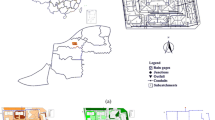Abstract
Runoff peak and volume in flood studies are estimated relying on temporal rainfall distribution from various storm patterns. Usually, SCS distributions types (I, II, III, IA) are commonly used. Using these distributions in runoff calculations assume that the in situ temporal rainfall pattern typically behaves as the one described by the SCS-type distribution, which is due to cyclonic frontal storms and actually developed in temperate environment. To what extent such assumption is valid in the arid environment? How much the impacts of rainfall temporal patterns are reflected in runoff volumes and peaks? The aim objectives of the current study are to answer the above two questions and clarify the validity of aforementioned assumption and exemplify such effect. Real rainfall data collected from rain gauges of Makkah Al-Mukkramah region over a period of more than 20 years are utilized. Temporal rainfall patterns and their parameters are deduced. Many hydrological simulations are performed and comparisons, in terms of runoff volume and peak flows, are made to show the effects of the common rainfall storm patterns and the developed rainfall storm patterns in the region based on the current study. Results indicate that major bursts of the design rainfall storm pattern are located in the first time of the storm period in the two quartiles which is mainly due to convective rainfall type in thunderstorms unlike the commonly used by SCS types relying on frontal cyclonic storms. Makkah Al-Mukkramah temporal rainfall pattern does not behave as the “typical pattern” assumed by SCS distributions that are deduced from different environments. The impacts of the temporal pattern reflected as an overestimate in the runoff peak reached to 68 %. The developed hyetographs and tables presented in the current study are recommended to enhance economical and rational design practice in watersheds of Makkah Al-Mukkramah region.













Similar content being viewed by others
References
Abo-Monasar A, Al-Zahrani MA (2014) Estimation of rainfall distribution for the southwestern region of Saudi Arabia. Hydrological Sciences Journal – Journal des Sciences Hydrologiques 59(2):420–431. doi:10.1080/02626667.2013.872788
Alyamani MS, Sen Z (1993) Regional variations of monthly rainfall amounts in the Kingdom of Saudi Arabia. Journal of King Abdulaziz University – Earth Sciences 6: 113–133. H (1413 A.H., 1993 A.D.) Saudi Arabia
Bonta JV (2004) Stochastic simulation of storms occurrence, depth, duration, and within-storm intensities. American Society of Agricultural Engineers 47(5):1573–1584
Brunner M (2014) Modeling the influence of spatial and temporal precipitation variability on the peak discharge of the Simme basin in the Berner Oberland. Masterarbeit der philosophisch-naturwissenschaftlichen Fakultat der Universitat Bern. (cD-Version CHF15). http://www.hydrologie.unibe.ch/projekte/poster/Poster_BRUNNER.pdf
De Lima JLMP, Singh VP (2002) The influence of the pattern of moving rainstorms on overland flow. Adv Water Resour 25(7):817–828
Elfeki AM, Ewea HA, Al-Amri N (2011) Simulation of urban flooding by diffusive wave model: Jeddah flood 2009 case study, First International Geomatics Symposium in Saudi Arabia. King Abdel Aziz Univ, Jeddah
Elfeki AM, Ewea HA, Al-Amri N (2014) Development of storm hyetographs for flood forecasting in the Kingdom of Saudi Arabia. Arab J Geosci 7:4387–4398. doi:10.1007/s12517-013-1102-3
HEC (2000) Hydrologic modeling system. Technical reference manual, US Army Corps of Engineers, Hydrologic Engineering Center, Davis, CA
Huff FA (1967) Time distribution of rainfall in heavy storms. Water Resour. Res. 3:1007–1019
Jaedi KM (2013) Urban flooding hazards modeling in arid zone, case study in Jeddah city, M.SC thesis, King Abdel Aziz university, Jeddah, Saudi Arabia
Environmental Modeling Research Laboratory (2004) http://www.emsi.com/WMS/WMS_Overview/wms_overview.htm
Subyani AM (2004) Gostatistical study of annual and seasonal mean rainfall patterns in southwest Saudi Arabia. Hydrological Sciences–Journal–des Sciences Hydrologiques 49(5):803–817
Viessman W, Knapp JW, Lewis GL, Harbauqh TE (1977) Introduction to hydrology. Happer & Row Publisher, New York
Acknowledgment
The authors would like to thank Mr. Abdelaziz Al-Bishri and Mr. Abdullah Al-Maliki, the technicians at the department of hydrology and water resources management, Faculty of Meteorology, Environment and Arid Land Agriculture, King Abdulaziz University for keen helping. The first author is on leave from Faculty of Engineering, Azhar University, Cairo, Egypt, and the second author is on leave from Faculty of Engineering, Mansoura University, Mansoura, Egypt.
Author information
Authors and Affiliations
Corresponding author
Rights and permissions
About this article
Cite this article
Ewea, H.A., Elfeki, A.M.M., Bahrawi, J.A. et al. Sensitivity analysis of runoff hydrographs due to temporal rainfall patterns in Makkah Al-Mukkramah region, Saudi Arabia. Arab J Geosci 9, 424 (2016). https://doi.org/10.1007/s12517-016-2443-5
Received:
Accepted:
Published:
DOI: https://doi.org/10.1007/s12517-016-2443-5




